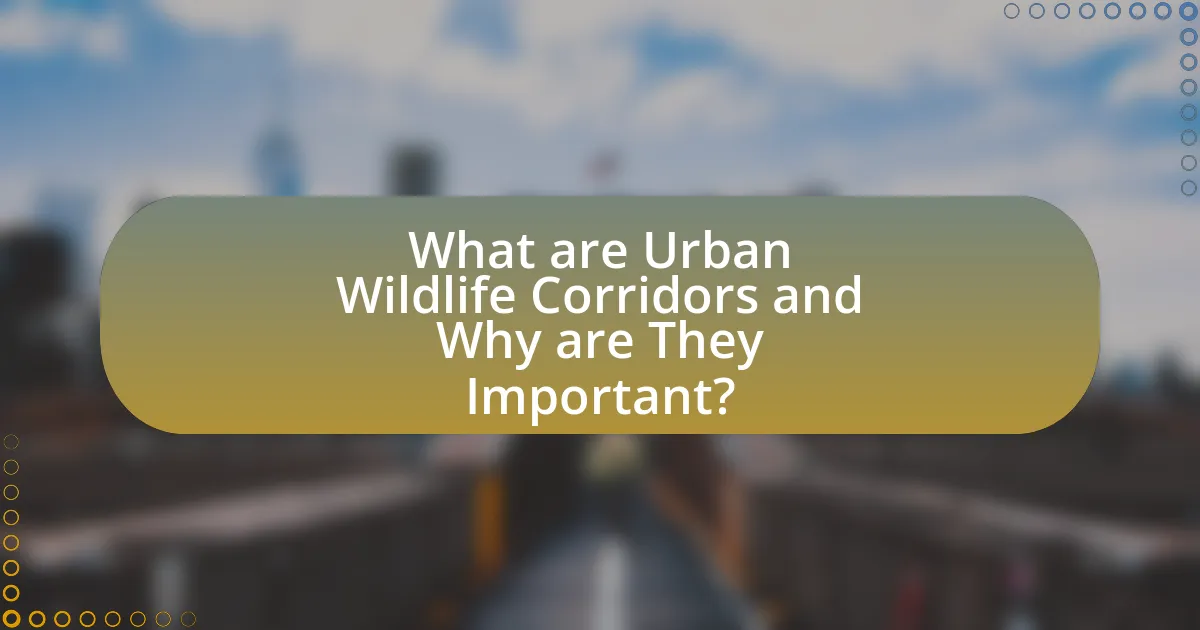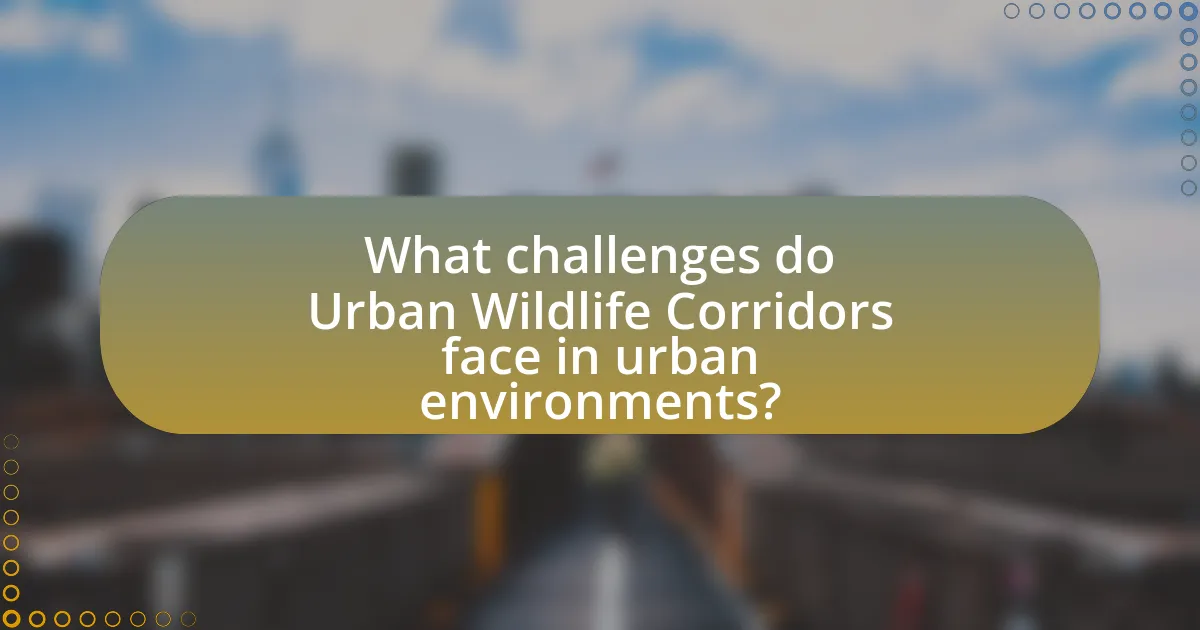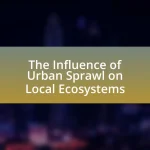Urban wildlife corridors are essential pathways that enable wildlife to navigate fragmented habitats in urban areas, playing a crucial role in maintaining biodiversity. These corridors facilitate animal movement, reduce roadkill incidents, and promote genetic diversity among species. The article explores the functionality of urban wildlife corridors within city ecosystems, the types of wildlife that benefit from them, and their significance in biodiversity conservation. It also addresses the integration of these corridors into urban planning, the challenges they face, and the importance of community involvement in their success. Additionally, it highlights best practices and technological advancements that can enhance the effectiveness of urban wildlife corridors in fostering healthier urban environments.

What are Urban Wildlife Corridors and Why are They Important?
Urban wildlife corridors are designated pathways that facilitate the movement of wildlife between fragmented habitats in urban areas. These corridors are important because they help maintain biodiversity, allowing species to access food, mates, and shelter, which is crucial for their survival and reproduction. Research indicates that urban wildlife corridors can significantly reduce roadkill incidents and promote genetic diversity among animal populations by connecting isolated groups. For example, studies have shown that the implementation of wildlife corridors in cities like Los Angeles has led to increased sightings of species such as coyotes and bobcats, demonstrating their effectiveness in urban planning.
How do Urban Wildlife Corridors function within city ecosystems?
Urban wildlife corridors function within city ecosystems by providing essential pathways that connect fragmented habitats, allowing wildlife to move freely between areas for foraging, breeding, and migration. These corridors enhance biodiversity by facilitating gene flow among animal populations, which is crucial for their survival and adaptation. Research indicates that urban wildlife corridors can significantly increase species richness; for example, a study published in “Ecological Applications” by Beninde et al. (2015) found that urban green corridors supported a higher diversity of bird species compared to isolated green spaces. By integrating these corridors into city planning, urban environments can support healthier ecosystems and mitigate the negative impacts of urbanization on wildlife.
What types of wildlife benefit from Urban Wildlife Corridors?
Urban wildlife corridors benefit various types of wildlife, including mammals, birds, reptiles, and amphibians. These corridors facilitate safe movement and access to resources, which is crucial for species such as deer, foxes, raccoons, and various bird species that rely on connectivity between habitats. Research indicates that urban wildlife corridors can significantly enhance biodiversity by providing essential pathways that reduce road mortality and habitat fragmentation, thereby supporting the survival of urban-adapted species and promoting ecological resilience.
How do Urban Wildlife Corridors facilitate animal movement?
Urban wildlife corridors facilitate animal movement by providing safe passageways that connect fragmented habitats within urban environments. These corridors allow wildlife to traverse areas that would otherwise be barriers due to roads, buildings, or other human developments. Research indicates that wildlife corridors can significantly reduce roadkill incidents and enhance genetic diversity by enabling animals to access different populations. For example, a study published in the journal “Ecological Applications” found that corridors increased the movement of species such as deer and coyotes by 50% in urban settings, demonstrating their effectiveness in promoting safe animal movement.
What role do Urban Wildlife Corridors play in biodiversity conservation?
Urban Wildlife Corridors play a crucial role in biodiversity conservation by facilitating the movement of species between fragmented habitats in urban areas. These corridors help maintain genetic diversity, allowing wildlife populations to interbreed and adapt to changing environments. Research indicates that urban wildlife corridors can significantly reduce roadkill incidents and promote species survival, as evidenced by studies showing increased animal movement and diversity in areas with established corridors. For instance, a study published in the journal “Ecological Applications” found that wildlife corridors in urban settings improved connectivity for species such as deer and raccoons, enhancing their chances of survival and reproduction.
Why is biodiversity crucial for urban environments?
Biodiversity is crucial for urban environments because it enhances ecosystem services that support human health and well-being. Diverse species contribute to air and water purification, pollination of plants, and climate regulation, which are essential in densely populated areas. For instance, urban green spaces with a variety of plants can reduce heat islands and improve air quality, leading to better public health outcomes. Studies have shown that cities with higher biodiversity levels experience lower rates of respiratory diseases and improved mental health among residents. Therefore, maintaining biodiversity in urban settings is vital for sustainable city planning and improving the quality of life for inhabitants.
How do Urban Wildlife Corridors contribute to ecosystem services?
Urban wildlife corridors enhance ecosystem services by facilitating species movement, promoting biodiversity, and improving habitat connectivity. These corridors allow wildlife to access food, mates, and shelter, which is crucial for maintaining healthy populations and genetic diversity. Research indicates that urban wildlife corridors can increase species richness by up to 30% in fragmented landscapes, thereby supporting ecosystem functions such as pollination, seed dispersal, and pest control. Additionally, these corridors contribute to climate regulation by preserving green spaces that absorb carbon dioxide and mitigate urban heat effects.

How are Urban Wildlife Corridors integrated into City Planning?
Urban wildlife corridors are integrated into city planning through strategic zoning, land use policies, and infrastructure design that prioritize ecological connectivity. City planners assess existing wildlife habitats and migration patterns to identify critical areas for corridor development, ensuring that these pathways facilitate safe animal movement across urban landscapes. For instance, cities like Los Angeles have implemented greenways and overpasses specifically designed for wildlife, which have been shown to reduce roadkill and promote biodiversity. Additionally, urban planning frameworks increasingly incorporate environmental impact assessments that mandate the inclusion of wildlife corridors in new developments, reflecting a growing recognition of their role in maintaining ecological balance within urban environments.
What are the key considerations for incorporating Urban Wildlife Corridors in urban design?
Key considerations for incorporating Urban Wildlife Corridors in urban design include habitat connectivity, species diversity, and community engagement. Habitat connectivity ensures that wildlife can move freely between fragmented habitats, which is crucial for maintaining genetic diversity and ecosystem health. Research indicates that urban areas can support a variety of species if designed with green spaces that connect to larger natural areas, as seen in studies by the University of California, which highlight the importance of green corridors for urban biodiversity. Additionally, involving the community in the planning process fosters support and awareness, leading to more successful implementation of wildlife corridors. Engaging local stakeholders can also help identify specific needs and preferences, ensuring that the corridors serve both wildlife and human populations effectively.
How do planners assess the need for Urban Wildlife Corridors?
Planners assess the need for Urban Wildlife Corridors by analyzing habitat fragmentation, species movement patterns, and biodiversity metrics. They utilize geographic information systems (GIS) to map existing wildlife habitats and identify barriers such as roads and buildings that disrupt animal migration. Studies indicate that urban areas with connected green spaces support higher biodiversity, as seen in research published by the Journal of Urban Ecology, which highlights that corridors can enhance species survival rates by facilitating gene flow. Additionally, planners often engage with ecological assessments and community input to prioritize areas that require connectivity, ensuring that urban development aligns with wildlife conservation goals.
What design elements are essential for effective Urban Wildlife Corridors?
Effective urban wildlife corridors require several essential design elements, including connectivity, habitat diversity, and permeability. Connectivity ensures that wildlife can move freely between habitats, reducing fragmentation caused by urban development. Habitat diversity provides various ecological niches, supporting a wider range of species. Permeability allows animals to navigate through urban landscapes, utilizing features like green bridges, tunnels, and native vegetation to facilitate safe passage. Research indicates that corridors designed with these elements significantly enhance biodiversity and ecosystem resilience in urban areas.
How can community involvement enhance the effectiveness of Urban Wildlife Corridors?
Community involvement can enhance the effectiveness of Urban Wildlife Corridors by fostering local stewardship and increasing public awareness of biodiversity. Engaged communities are more likely to participate in the planning and maintenance of these corridors, ensuring they meet both ecological needs and community interests. For instance, studies have shown that when residents are actively involved in the design and upkeep of wildlife corridors, there is a higher likelihood of successful wildlife movement and habitat connectivity. This is evidenced by the success of projects like the Los Angeles River Revitalization, where community input led to improved habitat features that support diverse species. Additionally, community-led initiatives can promote educational programs that raise awareness about the importance of wildlife corridors, further enhancing their effectiveness by encouraging responsible behaviors that protect these vital ecosystems.
What strategies can be employed to engage local communities?
To engage local communities in the context of urban wildlife corridors, strategies such as participatory planning, educational workshops, and community-led initiatives can be employed. Participatory planning involves involving community members in the decision-making process, ensuring their voices are heard and their needs are addressed. Educational workshops can raise awareness about the benefits of wildlife corridors, fostering a sense of ownership and responsibility among residents. Community-led initiatives, such as local clean-up events or habitat restoration projects, can actively involve residents in the conservation efforts, creating a stronger connection to the urban environment. These strategies have been shown to enhance community involvement and support for urban wildlife initiatives, as evidenced by successful case studies in cities like Portland and Vancouver, where community engagement has led to increased biodiversity and improved urban ecosystems.
How does public awareness impact the success of Urban Wildlife Corridors?
Public awareness significantly enhances the success of Urban Wildlife Corridors by fostering community support and engagement in conservation efforts. When the public understands the ecological benefits of these corridors, such as promoting biodiversity and facilitating wildlife movement, they are more likely to advocate for their preservation and integration into urban planning. Studies have shown that increased public knowledge leads to higher participation in local conservation initiatives, which can directly influence policy decisions and funding allocations for wildlife corridors. For instance, a survey conducted by the National Wildlife Federation indicated that communities with higher awareness levels were more likely to support local wildlife conservation projects, demonstrating a clear link between public awareness and the effectiveness of Urban Wildlife Corridors.

What challenges do Urban Wildlife Corridors face in urban environments?
Urban wildlife corridors face significant challenges in urban environments, primarily due to habitat fragmentation, human activity, and pollution. Habitat fragmentation occurs when urban development divides natural habitats, making it difficult for wildlife to navigate and access resources. Human activity, including traffic and construction, poses risks to wildlife safety and can lead to increased mortality rates. Additionally, pollution from urban areas can degrade the quality of habitats, affecting the health and survival of various species. These challenges hinder the effectiveness of wildlife corridors in promoting biodiversity and ecological connectivity in cities.
What are the common obstacles to establishing Urban Wildlife Corridors?
Common obstacles to establishing Urban Wildlife Corridors include land use conflicts, funding limitations, and regulatory challenges. Land use conflicts arise when urban development priorities clash with the need for wildlife habitats, often leading to resistance from property owners and developers. Funding limitations hinder the implementation of corridor projects, as financial resources are often allocated to other urban infrastructure needs. Regulatory challenges, such as zoning laws and environmental regulations, can complicate the planning and approval processes, making it difficult to create continuous and effective wildlife pathways. These factors collectively impede the successful establishment of Urban Wildlife Corridors, which are essential for biodiversity and ecological health in urban environments.
How do urban development pressures affect the creation of these corridors?
Urban development pressures significantly hinder the creation of wildlife corridors by prioritizing land for housing, commercial, and infrastructure projects over ecological needs. As cities expand, natural habitats are fragmented, reducing connectivity for wildlife and limiting their movement between essential resources. For instance, a study by the University of California found that urban sprawl can decrease habitat availability by up to 50%, directly impacting biodiversity and species survival. This competition for land often leads to the neglect of planning for wildlife corridors, which are crucial for maintaining ecological balance in urban environments.
What role does climate change play in the effectiveness of Urban Wildlife Corridors?
Climate change significantly impacts the effectiveness of Urban Wildlife Corridors by altering habitat conditions and species distributions. As temperatures rise and weather patterns shift, the flora and fauna that these corridors aim to support may become less viable in their current locations, leading to decreased biodiversity. For instance, studies indicate that climate change can shift species ranges, forcing wildlife to migrate to new areas that may not be connected by existing corridors, thereby undermining their intended purpose. Additionally, extreme weather events, such as floods and droughts, can damage the infrastructure of these corridors, further limiting their effectiveness in facilitating wildlife movement and genetic exchange.
How can cities overcome challenges related to Urban Wildlife Corridors?
Cities can overcome challenges related to Urban Wildlife Corridors by implementing integrated planning strategies that prioritize habitat connectivity. This involves designing green spaces that link fragmented habitats, utilizing native vegetation to support local wildlife, and incorporating wildlife-friendly infrastructure such as overpasses and underpasses. For instance, the city of Los Angeles has successfully integrated wildlife corridors into its urban planning, which has led to increased biodiversity and reduced wildlife-vehicle collisions. Studies show that effective urban wildlife corridors can enhance species movement and genetic diversity, demonstrating their critical role in urban ecosystems.
What best practices can be implemented to ensure successful corridor development?
Successful corridor development can be ensured by integrating ecological assessments, stakeholder engagement, and adaptive management practices. Conducting thorough ecological assessments allows planners to identify critical habitats and species needs, which is essential for designing effective corridors. Engaging stakeholders, including local communities and conservation organizations, fosters collaboration and support, ensuring that diverse perspectives are considered in the planning process. Implementing adaptive management practices enables continuous monitoring and adjustments based on ecological feedback, which is crucial for maintaining corridor effectiveness over time. These best practices are supported by studies indicating that well-planned corridors enhance biodiversity and connectivity, ultimately contributing to healthier urban ecosystems.
How can technology aid in the planning and maintenance of Urban Wildlife Corridors?
Technology aids in the planning and maintenance of Urban Wildlife Corridors by utilizing data analytics, geographic information systems (GIS), and remote sensing. Data analytics allows urban planners to assess wildlife movement patterns and habitat needs, enabling the design of effective corridors that facilitate animal migration. Geographic information systems provide spatial analysis tools that help visualize and plan the integration of these corridors within urban landscapes, ensuring connectivity between habitats. Remote sensing technologies, such as drones and satellite imagery, enable ongoing monitoring of corridor conditions, allowing for timely maintenance and adjustments based on environmental changes or wildlife activity. These technological applications enhance the effectiveness of urban wildlife corridors, promoting biodiversity and ecological health in urban settings.
What are practical steps for advocating Urban Wildlife Corridors in your community?
To advocate for Urban Wildlife Corridors in your community, start by conducting research to identify key areas where wildlife movement is hindered. Engage with local environmental organizations to gather support and resources. Organize community meetings to raise awareness about the benefits of wildlife corridors, such as biodiversity preservation and ecosystem health. Collaborate with urban planners and local government officials to integrate wildlife corridors into city planning initiatives. Present data on successful urban wildlife corridors from other cities, demonstrating their positive impact on both wildlife and community well-being. For instance, the city of San Francisco has successfully implemented wildlife corridors that have improved urban biodiversity and reduced human-wildlife conflicts.


